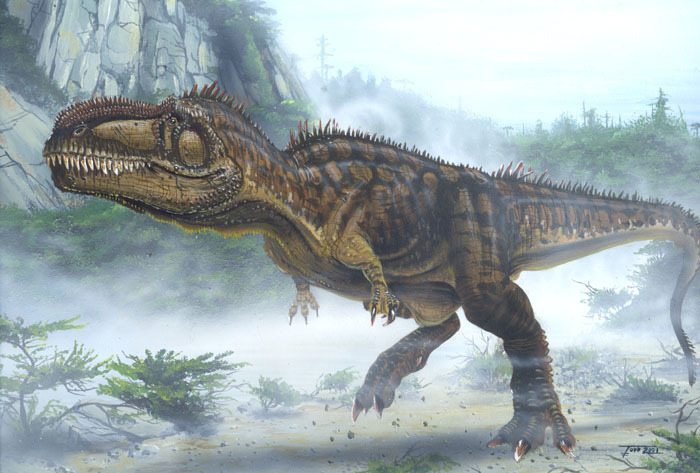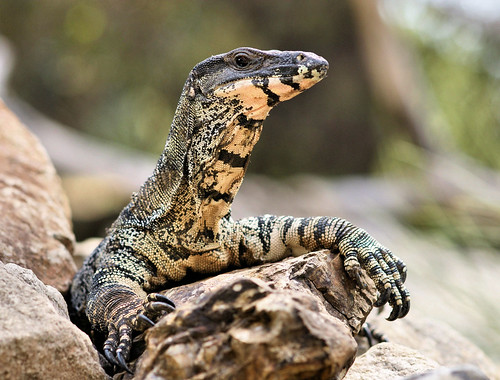Post by DinosaurMichael on Apr 27, 2012 6:18:18 GMT -5
Giganotosaurus - Giganotosaurus carolinii
Giganotosaurus (pronounced /ˌdʒaɪɡəˌnoʊtəˈsɔrəs/ JY-gə-NOH-tə-SOR-əs) is a genus of carcharodontosaurid dinosaur that lived around 97 million years ago during the early Cenomanian stage of the Late Cretaceous Period. It included some of the largest known terrestrial carnivores, slightly larger than the largest Tyrannosaurus, but smaller than the largest Spinosaurus and Carcharodontosaurus. Its fossils have been found in Argentina. The most complete find of Giganotosaurus was made by Rubén Dario Carolini, an amateur fossil hunter who, on 25 July 1993, discovered a skeleton in deposits of Patagonia (southern Argentina) in what is now considered the Candeleros Formation. The discovery was scientifically reported in 1994. The initial description was published by Rodolfo Coria and Leonardo Salgado in the journal Nature in September 1995. The type species is Giganotosaurus carolinii. The generic name means "giant southern lizard", derived from the Ancient Greek gigas/γίγας meaning "giant", notos/νότος meaning "south wind" and -sauros/-σαύρος meaning "lizard". The specific name honours Carolini. The holotype specimen's (MUCPv-Ch1) skeleton was about 70% complete and included parts of the skull, a lower jaw, pelvis, hindlimbs and most of the backbone. The premaxillae, jugals, quadratojugals, the back of the lower jaws and the forelimbs are missing. Various estimates find that it measured somewhere between 12.2 and 13 m (40 and 43 ft) in length, and between 6.5 and 13.3 tons in weight. A second, more fragmentary, specimen (MUCPv-95) has also been identified, found in 1987 by Jorge Calvo. It is only known from the front part of the left dentary which is 8% larger than the equivalent bone from the holotype. This largest Giganotosaurus specimen is estimated to represent an individual with a skull length of 195 cm (6.40 ft), compared to the holotype's estimated at 1.80 m (5.9 ft) skull, making it likely that Giganotosaurus had the largest skull of any known theropod. Giganotosaurus surpassed Tyrannosaurus in mass by at least half a ton (the upper size estimate for T. rex is 9.1 t). Additionally several single teeth, discovered from 1987 onwards, have been referred to the species.

Carcharodontosaurus - Carcharodontosaurus saharicus
Carcharodontosaurus ( /ˌkɑrkərɵˌdɒntɵˈsɔrəs/) was a gigantic carnivorous carcharodontosaurid dinosaur that lived around 100 to 93 million years ago, during the late Albian to early Cenomanian stages of the mid-Cretaceous Period. It was discovered to be the second largest predatory dinosaur, larger than Tyrannosaurus and Giganotosaurus, but not as large as Spinosaurus. The Carcharodontosaurus is named after the shark genus Carcharodon (from the Greek καρχαρο karcharo meaning "jagged" or "sharp" and οδοντο odonto meaning "teeth", and σαυρος sauros, meaning "lizard") — "jagged-toothed lizard" or "sharp-toothed lizard". Carcharodontosaurus is one of the longest and heaviest known carnivorous dinosaurs, with various scientists proposing length estimates ranging between 12 and 13 m (39-43.5 ft) and weight estimates between 6 and 15 metric tons. Carcharodontosaurus was a carnivore, with enormous jaws and long, serrated teeth up to eight inches long. Paleontologists once thought that Carcharodontosaurus had the longest skull of any of the theropod dinosaurs. However, the premaxilla and quadrate bones were missing from the original African skull, which led to misinterpretation of its actual size by researchers. A more modest length of 1.6 meters (5.2 ft) has now been proposed for C. saharicus, and the skull of C. iguidensis is reported to have been about the same size. Currently, the largest known theropod skull belongs to another huge carcharodontosaurid dinosaur, the closely related Giganotosaurus (with skull length estimates up to 1.95 m) (6.3 ft).

Giganotosaurus (pronounced /ˌdʒaɪɡəˌnoʊtəˈsɔrəs/ JY-gə-NOH-tə-SOR-əs) is a genus of carcharodontosaurid dinosaur that lived around 97 million years ago during the early Cenomanian stage of the Late Cretaceous Period. It included some of the largest known terrestrial carnivores, slightly larger than the largest Tyrannosaurus, but smaller than the largest Spinosaurus and Carcharodontosaurus. Its fossils have been found in Argentina. The most complete find of Giganotosaurus was made by Rubén Dario Carolini, an amateur fossil hunter who, on 25 July 1993, discovered a skeleton in deposits of Patagonia (southern Argentina) in what is now considered the Candeleros Formation. The discovery was scientifically reported in 1994. The initial description was published by Rodolfo Coria and Leonardo Salgado in the journal Nature in September 1995. The type species is Giganotosaurus carolinii. The generic name means "giant southern lizard", derived from the Ancient Greek gigas/γίγας meaning "giant", notos/νότος meaning "south wind" and -sauros/-σαύρος meaning "lizard". The specific name honours Carolini. The holotype specimen's (MUCPv-Ch1) skeleton was about 70% complete and included parts of the skull, a lower jaw, pelvis, hindlimbs and most of the backbone. The premaxillae, jugals, quadratojugals, the back of the lower jaws and the forelimbs are missing. Various estimates find that it measured somewhere between 12.2 and 13 m (40 and 43 ft) in length, and between 6.5 and 13.3 tons in weight. A second, more fragmentary, specimen (MUCPv-95) has also been identified, found in 1987 by Jorge Calvo. It is only known from the front part of the left dentary which is 8% larger than the equivalent bone from the holotype. This largest Giganotosaurus specimen is estimated to represent an individual with a skull length of 195 cm (6.40 ft), compared to the holotype's estimated at 1.80 m (5.9 ft) skull, making it likely that Giganotosaurus had the largest skull of any known theropod. Giganotosaurus surpassed Tyrannosaurus in mass by at least half a ton (the upper size estimate for T. rex is 9.1 t). Additionally several single teeth, discovered from 1987 onwards, have been referred to the species.

Carcharodontosaurus - Carcharodontosaurus saharicus
Carcharodontosaurus ( /ˌkɑrkərɵˌdɒntɵˈsɔrəs/) was a gigantic carnivorous carcharodontosaurid dinosaur that lived around 100 to 93 million years ago, during the late Albian to early Cenomanian stages of the mid-Cretaceous Period. It was discovered to be the second largest predatory dinosaur, larger than Tyrannosaurus and Giganotosaurus, but not as large as Spinosaurus. The Carcharodontosaurus is named after the shark genus Carcharodon (from the Greek καρχαρο karcharo meaning "jagged" or "sharp" and οδοντο odonto meaning "teeth", and σαυρος sauros, meaning "lizard") — "jagged-toothed lizard" or "sharp-toothed lizard". Carcharodontosaurus is one of the longest and heaviest known carnivorous dinosaurs, with various scientists proposing length estimates ranging between 12 and 13 m (39-43.5 ft) and weight estimates between 6 and 15 metric tons. Carcharodontosaurus was a carnivore, with enormous jaws and long, serrated teeth up to eight inches long. Paleontologists once thought that Carcharodontosaurus had the longest skull of any of the theropod dinosaurs. However, the premaxilla and quadrate bones were missing from the original African skull, which led to misinterpretation of its actual size by researchers. A more modest length of 1.6 meters (5.2 ft) has now been proposed for C. saharicus, and the skull of C. iguidensis is reported to have been about the same size. Currently, the largest known theropod skull belongs to another huge carcharodontosaurid dinosaur, the closely related Giganotosaurus (with skull length estimates up to 1.95 m) (6.3 ft).





